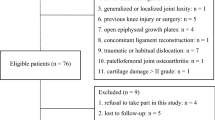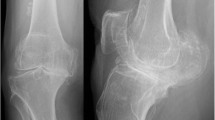Abstract
Purpose
The purpose of the present study was to use arthroscopy to evaluate the effect of distal tuberosity osteotomy (DTO) in open-wedge high tibial osteotomy (OW-HTO) on patellofemoral (PF) cartilage degradation.
Methods
Between 2012 and 2017, 46 knees underwent DTO in OW-HTO, and 65 knees underwent conventional OW-HTO (cOW-HTO). To assess changes in patellar height, the Blackburne–Peel (BP) ratio and the Caton–Deschamps (CD) index were measured. Arthroscopic evaluation on the PF joint was performed at the initial osteotomy and at the second-look procedure 1 year later. Statistical analyses were performed to compare difference between the DTO and the cOW-HTO group.
Results
In the cOW-HTO group, the mean BP ratio and CD index decreased significantly from 0.81 and 0.89 preoperatively, respectively, to 0.69 and 0.76 postoperatively, respectively (p < 0.001). In contrast, the DTO group maintained a consistent patellar height; the mean BP ratio and CD index were 0.77 and 0.83 preoperatively, respectively, and 0.73 and 0.80 postoperatively, respectively. Upon arthroscopic evaluation, 39 of 46 patients (84.8%) in the DTO group showed no progression of PF cartilage degradation at the second look; indeed, five of 46 patients (10.9%) even demonstrated improvement. In contrast, 21 of 65 patients (32.3%) in the cOW-HTO group exhibited increased PF cartilage degradation. There was a significant difference in progression of PF cartilage degradation between DTO and cOW-HTO (p < 0.001).
Conclusion
DTO in OW-HTO maintained the preoperative patellar height, which could help prevent progression of cartilage degeneration in the PF joint after surgery. In respect of the biplanar osteotomy direction in OW-HTO, the DTO, rather than cOWHTO, is the preferred technique for the treatment of varus knee osteoarthritis to avoid progression of PF cartilage degradation.
Level of evidence
III.


Similar content being viewed by others
Abbreviations
- HTO:
-
High tibial osteotomy
- OA:
-
Osteoarthritis
- OW:
-
Open-wedge
- cOW-HTO:
-
Conventional open-wedge high tibial osteotomy
- PF:
-
Patellofemoral
- DTO:
-
Distal tuberosity osteotomy
- CD:
-
Caton–Deschamps
- BMI:
-
Body mass index
- BP:
-
Blackburne–Peel
- FTA:
-
Femoro-tibial angle
- JOA:
-
Japanese Orthopaedic Association
- ICRS:
-
International Cartilage Repair Society
References
Amis AA (2013) Biomechanics of high tibial osteotomy. Knee Surg Sports Traumatol Arthrosc 21:197–205
Bito H, Takeuchi R, Kumagai K, Aratake M, Saito I, Hayashi R et al (2010) Opening wedge high tibial osteotomy affects both the lateral patellar tilt and patellar height. Knee Surg Sports Traumatol Arthrosc 18:955–960
Blackman AJ, Krych AJ, Engasser WM, Levy BA, Stuart MJ (2015) Does proximal tibial osteotomy with a novel osteotomy system obtain coronal plane correction without affecting tibial slope and patellar height? Knee Surg Sports Traumatol Arthrosc 23:3487–3493
Brinkman JM, Lobenhoffer P, Agneskirchner JD, Staubli AE, Wymenga AB, van Heerwaarden RJ (2008) Osteotomies around the knee: patient selection, stability of fixation and bone healing in high tibial osteotomies. J Bone Joint Surg Br 90:1548–1557
Brouwer RW, Bierma-Zeinstra SM, van Koeveringe AJ, Verhaar JA (2005) Patellar height and the inclination of the tibial plateau after high tibial osteotomy. The open versus the closed-wedge technique. J Bone Joint Surg Br 87:1227–1232
El-Azab H, Glabgly P, Paul J, Imhoff AB, Hinterwimmer S (2010) Patellar height and posterior tibial slope after open- and closed-wedge high tibial osteotomy: a radiological study on 100 patients. Am J Sports Med 38:323–329
Esenkaya I, Unay K (2012) Proximal medial tibial biplanar retrotubercle open wedge osteotomy in medial knee arthrosis. Knee 19:416–421
Gaasbeek R, Welsing R, Barink M, Verdonschot N, van Kampen A (2007) The influence of open and closed high tibial osteotomy on dynamic patellar tracking: a biomechanical study. Knee Surg Sports Traumatol Arthrosc 15:978–984
Gaasbeek RD, Sonneveld H, van Heerwaarden RJ, Jacobs WC, Wymenga AB (2004) Distal tuberosity osteotomy in open wedge high tibial osteotomy can prevent patella infera: a new technique. Knee 11:457–461
Goshima K, Sawaguchi T, Shigemoto K, Iwai S, Nakanishi A, Ueoka K (2017) Patellofemoral osteoarthritis progression and alignment changes after open-wedge high tibial osteotomy do not affect clinical outcomes at mid-term follow-up. Arthroscopy 33:1832–1839
Ishimatsu T, Takeuchi R, Ishikawa H, Yamaguchi Y, Maeyama A, Osawa K et al (2019) Hybrid closed wedge high tibial osteotomy improves patellofemoral joint congruity compared with open wedge high tibial osteotomy. Knee Surg Sports Traumatol Arthrosc. https://doi.org/10.1007/s00167-019-05350-4
Keyhani S, Abbasian MR, Kazemi SM, Esmailiejah AA, Seyed Hosseinzadeh HR, Shahi A et al (2011) Modified retro-tubercle opening-wedge versus conventional high tibial osteotomy. Orthopedics 34:90
Kim KI, Kim DK, Song SJ, Lee SH, Bae DK (2017) Medial open-wedge high tibial osteotomy may adversely affect the patellofemoral joint. Arthroscopy 33:811–816
Kloos F, Becher C, Fleischer B, Feucht MJ, Hohloch L, Sudkamp N et al (2018) High tibial osteotomy increases patellofemoral pressure if adverted proximal, while open-wedge HTO with distal biplanar osteotomy discharges the patellofemoral joint: different open-wedge high tibial osteotomies compared to an extra-articular unloading device. Knee Surg Sports Traumatol Arthrosc. https://doi.org/10.1007/s00167-018-5194-x
Krause M, Drenck TC, Korthaus A, Preiss A, Frosch KH, Akoto R (2018) Patella height is not altered by descending medial open-wedge high tibial osteotomy (HTO) compared to ascending HTO. Knee Surg Sports Traumatol Arthrosc 26:1859–1866
LaPrade RF, Oro FB, Ziegler CG, Wijdicks CA, Walsh MP (2010) Patellar height and tibial slope after opening-wedge proximal tibial osteotomy: a prospective study. Am J Sports Med 38:160–170
Lee YS, Lee SB, Oh WS, Kwon YE, Lee BK (2016) Changes in patellofemoral alignment do not cause clinical impact after open-wedge high tibial osteotomy. Knee Surg Sports Traumatol Arthrosc 24:129–133
Longino PD, Birmingham TB, Schultz WJ, Moyer RF, Giffin JR (2013) Combined tibial tubercle osteotomy with medial opening wedge high tibial osteotomy minimizes changes in patellar height: a prospective cohort study with historical controls. Am J Sports Med 41:2849–2857
Okuda M, Omokawa S, Okahashi K, Akahane M, Tanaka Y (2012) Validity and reliability of the Japanese Orthopaedic Association score for osteoarthritic knees. J Orthop Sci 17:750–756
Otsuki S, Murakami T, Okamoto Y, Nakagawa K, Okuno N, Wakama H et al (2018) Hybrid high tibial osteotomy is superior to medial opening high tibial osteotomy for the treatment of varus knee with patellofemoral osteoarthritis. Knee Surg Sports Traumat, Arthrosc. https://doi.org/10.1007/s00167-018-5015-2
Park H, Kim HW, Kam JH, Lee DH (2017) Open wedge high tibial osteotomy with distal tubercle osteotomy lessens change in patellar position. Biomed Res Int 2017:4636809
Portner O (2014) High tibial valgus osteotomy: closing, opening or combined? Patellar height as a determining factor. Clin Orthop Relat Res 472:3432–3440
Schallberger A, Jacobi M, Wahl P, Maestretti G, Jakob RP (2011) High tibial valgus osteotomy in unicompartmental medial osteoarthritis of the knee: a retrospective follow-up study over 13–21 years. Knee Surg Sports Traumatol Arthrosc 19:122–127
Shim JS, Lee SH, Jung HJ, Lee HI (2013) High tibial open wedge osteotomy below the tibial tubercle: clinical and radiographic results. Knee Surg Sports Traumatol Arthrosc 21:57–63
Smith JO, Wilson AJ, Thomas NP (2013) Osteotomy around the knee: evolution, principles and results. Knee Surg Sports Traumatol Arthrosc 21:3–22
Smith TO, Sexton D, Mitchell P, Hing CB (2011) Opening- or closing-wedged high tibial osteotomy: a meta-analysis of clinical and radiological outcomes. Knee 18:361–368
Song IH, Song EK, Seo HY, Lee KB, Yim JH, Seon JK (2012) Patellofemoral alignment and anterior knee pain after closing- and opening-wedge valgus high tibial osteotomy. Arthroscopy 28:1087–1093
Stoffel K, Willers C, Korshid O, Kuster M (2007) Patellofemoral contact pressure following high tibial osteotomy: a cadaveric study. Knee Surg Sports Traumatol Arthrosc 15:1094–1100
Takeuchi R, Ishikawa H, Miyasaka Y, Sasaki Y, Kuniya T, Tsukahara S (2014) A novel closed-wedge high tibial osteotomy procedure to treat osteoarthritis of the knee: hybrid technique and rehabilitation measures. Arthrosc Tech 3:e431–e437
Tanaka T, Matsushita T, Miyaji N, Ibaraki K, Nishida K, Oka S et al (2018) Deterioration of patellofemoral cartilage status after medial open-wedge high tibial osteotomy. Knee Surg Sports Traumatol Arthrosc. https://doi.org/10.1007/s00167-018-5128-7
Author information
Authors and Affiliations
Corresponding author
Ethics declarations
Conflict of interest
The authors state that there are no conflicts of interest, which might have influenced the preparation of this manuscript.
Funding
No financial support was provided to this study.
Ethical approval
Ethical approval was provided by the IRB of Omuta Tenryo Hospital.
Additional information
Publisher's Note
Springer Nature remains neutral with regard to jurisdictional claims in published maps and institutional affiliations.
Rights and permissions
About this article
Cite this article
Horikawa, T., Kubota, K., Hara, S. et al. Distal tuberosity osteotomy in open-wedge high tibial osteotomy does not exacerbate patellofemoral osteoarthritis on arthroscopic evaluation. Knee Surg Sports Traumatol Arthrosc 28, 1750–1756 (2020). https://doi.org/10.1007/s00167-019-05596-y
Received:
Accepted:
Published:
Issue Date:
DOI: https://doi.org/10.1007/s00167-019-05596-y




